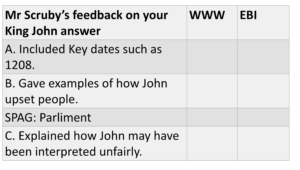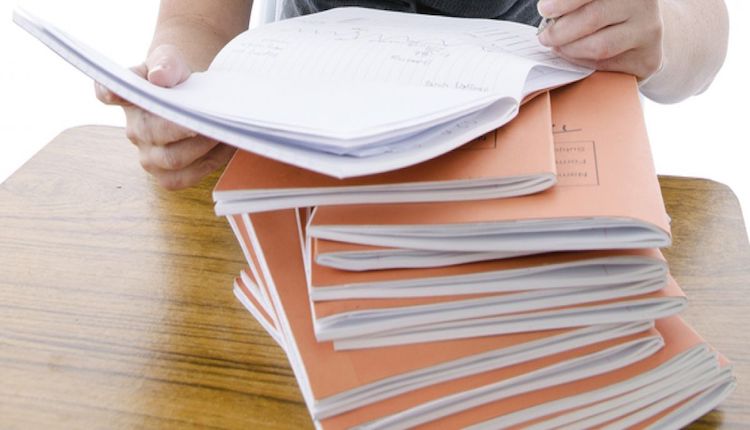We are all told how important feedback is. Written feedback especially.
The research.
The Education Endowment Foundation (EEF) research states “feedback studies tend to show very high effects on learning”. We know feedback is important.
SLTs love looking for this feedback as they can make it part of their accountability measures. Off they go, clip boards in hand, out of their comfortable offices, in search of piles of exercise books that show meaningful feedback comments from teachers and responses from students. Tick box pro-forma at the ready, pen poised. Easy data generated ready to analyse then beat you with.
We scratch our heads about how to create this flow of green and red ink AND plan our lessons well AND mark each book in more detail than ever before. Our blood pressure increases as we realise there isn’t the time to do what we have been asked.
My problem
I teach in a mixed 11-16 comprehensive school with approximately 1,160 on roll. There are just two full time history teachers (of which I am one) with a couple of hours scattered elsewhere on the day I work at the University of Sussex.
 This is not due to ‘cuts’, but timetabling – history is given just one hour a week at KS3. Most of this teaching burden falls on colleague, an NQT+ 1. She is amazing with a work ethic that is second to none. Each week Lily teaches 6x Y7, 2x Y8, 4x Y9, 1xY10, 1xY11 history. On top of this, 3x Y8 classics and 1x Y7 RS. That is a lot of students, 540 in fact!
This is not due to ‘cuts’, but timetabling – history is given just one hour a week at KS3. Most of this teaching burden falls on colleague, an NQT+ 1. She is amazing with a work ethic that is second to none. Each week Lily teaches 6x Y7, 2x Y8, 4x Y9, 1xY10, 1xY11 history. On top of this, 3x Y8 classics and 1x Y7 RS. That is a lot of students, 540 in fact!
Lily is at her limit. She is conscientious. We both hate box-ticking exercises.
There is no point in giving meaningless feedback.
Lily arrived in September from an under subscribed small challenging 11-16 academy. Her understanding of Dylan William’s AfL approaches made her attractive to us when interviewing. She was thoroughly informed about good feedback practices. Something our SLT were looking for after our recent Ofsted (are they to blame for this increase in marking – or is it SLTs response to Ofsted?)
We spent an INSET putting a lot of good practice into place. What did good written feedback look like? What went well? It was good in theory. Even better if? Lily had the number of students she had in her old school. Do this by? SLT finding the funds to increase the time history has on the timetable.
The solution(s).
I recently re-activated my Twitter account @MrScrubyHistory and discovered ‘The Marking Crib Sheet’. A wonderful contribution by @MrThorntonTeach. As a wider Humanities Department, we ran with it. We liked it. It kind of worked for us; reducing the workload slightly by reducing repetitive lengthy comments we were writing in exercise books. However, I always wanted to adapt the size and arrangement of the template. For my classes and the feedback I was giving, some boxes were crammed and, others sparse and empty.
Then, a light-bulb moment. I’ve been teaching GCSE Sociology for years, a big part of which included basic research methods. My Y11 sociologists could teach my SLT or Ofsted a thing or two about obtaining valid and reliable data! Anyway, the solution was sample marking.
I selected some work from higher, middle, lower ability students. In addition, I included SEND and PPI students to keep my eye on ‘the gap’ and thorough targeted feedback ensued. As for the crib sheet, I threw it away. I got an exercise book, scribbled the class name on the front and started on a double page spread that I could photocopy.
I stopped being precious about the task in hand. With a minimum template, I was free to say what I wanted to my students. After teaching the short King John enquiry it looked something like this:

The feedback was generated by reading through the sample. The list would normally run the length of half of the alphabet, but no more. Intermittently adding genuine SPaG mistakes.
Benefits
This method is not ideal. Ideally every students’ work would be read at the same time. The benefits outweigh the disadvantages though.
The feedback, by next lesson is very achievable.
When it gets to marking those end products, the extended writing pieces… or probably even better, after the students have just started writing their extended pieces, the teacher can mark just 5 books and give the whole class quality feedback the next lesson.
The A,B,C teacher feedback sheet is given to the students, they look through their work to see if they each one is a WWW or an EBI – and they improve their EBIs.
This has solved our marking crisis. The frequency of feedback increased. Each book gets read and fed back on eventually as the selected sample changes. Lily only have to read and mark 90 books, instead of 540! Obviously on some assessed pieces we mark each book, but not each time.
The benefits of the sample marking mean that the students have decent feedback by the next lesson and can improve their work much more regularly. If each book had to be marked in the traditional manner, they would get less regular feedback.




